-
Improving Transportation and Referral for Maternal Health
›“Referral has been called an orphan cause,” said Patricia Bailey, public health specialist for Family Health International and Columbia University, because it is “everybody’s responsibility and therefore nobody’s responsibility.”
As part of the Maternal Health Dialogue Series the Woodrow Wilson International Center for Scholars’ Global Health Initiative convened a small technical meeting on May 19, 2010, with 25 experts from five countries to discuss their experiences and share lessons, challenges, and recommendations for improving transportation and referral for maternal health. Following the technical meeting, a public dialogue was held on May 20, 2010, to share the knowledge gaps and recommendations identified. The formal report from the technical meeting will be available in the near future.
Mobilizing District Communities in Rural Ghana
To improve maternal health care in Ghana, “we needed to shift [services] to the community level, where 70 percent of our population lives,” said Dr. John Koku Awoonor-Williams, the east regional director of Ghana Health Service. The “Community-based Health Planning and Services” (CHPS) program was created to galvanize local leadership and empower communities to engage in health outreach activities.
Through this approach, “community health officers and nurses are trained and delegated to distant village locations called CH[I]P zones, in which they are responsible for health education, treatment of minor illnesses, maternal and antenatal care, and referral to district hospitals for emergency care,” said Awoonor-Williams. Community health officers use two-way Motorola walkie-talkies to communicate with traditional birth attendants and referral centers. Pregnant women are given the phone numbers so they can call in the event of complications.
1-0-8 Emergency Number for Improving Maternal Health in India
Many parts of the developing world do not have a 911-style emergency response service. To address this gap, the GVK Emergency Management & Research Institute in India developed the toll-free 1-0-8 telephone number for all medical, police, and fire emergencies.
“We assure every citizen that wherever you are, [if] you call us we will be there,” said Subodh Satyawadi, chief operating officer of GVK. In order to reach the 433 million people covered by GVK, they have:
“Although we address all kinds of emergencies, we heavily focus on maternal health…31 percent of emergencies are pregnancy-related,” said Satyawadi, who said that GVK’s emergency response system has helped save more than 200,000 mothers. Institutional deliveries have increased in the state of Gujarat by 92 percent. “We have been able to reduce maternal mortality by 20-25 percent in different geographies,” he said.- 19,623 EMTs and 10,000 doctors and other healthcare professionals
- 2,710 ambulances
- 16,300 call-center employees
Pre-Hospital Barriers: Reducing Maternal Morbidity in Bolivia
Women in Bolivia receive free maternal care. In cities like La Paz, emergency obstetric care is often available within a short distance. However, “37 percent of our maternal deaths [occur] at our hospitals,” said Víctor Conde Altamirano, OB/GYN of CARE Bolivia.
To better understand this mortality rate, Altamirano evaluated whether pre-hospital barriers and routine antenatal care are associated with near-miss morbidity. He found that women who are older, have lower levels of education, lack antenatal care, are pregnant for the first time, or live in rural areas are at a greatest risk of illness or death
“We are trying to organize our communities and service facilities, and promote improved health management by the municipalities. If our authorities can be sensitive and invest in health; invest in fuel, drugs, and human resources; we can improve near-miss morbidity rates,” said Altamirano.
Strategies and Recommendations for Improving Transportation & Referral
The workshop participants agreed on six key topic areas for improving transportation and referral:1. Multi-sectoral collaboration
The group called for improved multi-sectoral engagement and continuous dialogue among key ministries: Health, Finance, Communication, Social Welfare, Security and Defense, Transportation, and Public Works.
2. Mobile phone technology
3. Public-private partnerships
4. Referral for newborns
5. Indicators for referral
6. Sharing evidence
Private-public partnerships, such as those demonstrated by GVK in India and the CH[I]P program in Ghana, create opportunities for collaboration. “Cell-phone technology can reduce delays in transport and treatment by identifying which facilities might be the most appropriate for referral,” said Bailey.
The final recommendation by the group calls for increased pooling and use of existing evidence to move the transportation and referral agenda forward. Updated synthesis papers on existing evidence are needed, said Bailey. “We have a lot of data that is perhaps less than perfect, but this should not be a barrier for further action,” she said. -
Coffee and Contraception: Combining Agribusiness and Community Health Projects in Rwanda
›“Population pressures and diminishing land holdings – due to high fertility rates, war and genocide, and subsequent migration – have caused a rapid decrease in the forested and protected areas and increased soil infertility and food insecurity” in Rwanda, USAID’s Irene Kitzantides told a Wilson Center audience.
Kitzantides, a population, health, and environment advisor and global health fellow, said “the population is projected to reach over 14 million by 2025” – nearly one-third more than today, due to the country’s high fertility rate of nearly 5.5 children per women–which could continue to negatively impact forests and food supplies.
In response to these challenges, USAID supported the Sustaining Partnerships to Enhance Rural Enterprise and Agribusiness Development (SPREAD) Project. SPREAD uses an integrated population-health-environment (PHE) approach to develop the coffee agribusiness and bring family planning, HIV/AIDS, and reproductive health services to coffee workers.
Combining income generation with health services was thought an effective way to “fulfill the overall SPREAD goal of improving lives and livelihoods,” said Kitzantides.
A SPREADing Mandate: Integrating Health and Agribusiness
SPREAD follows USAID’s PEARL I and II Projects, which focused exclusively on agricultural development. Coffee is still at the center of SPREAD’s activities, with $5 million of the project’s $6 million USAID budget earmarked for agricultural development.
However, a broader mandate to include health services emerged after recognition that greater income alone does not ensure greater quality of life. The additional health funding leverages SPREAD’s already established relationships with farming cooperatives to bring health services to traditionally underserved rural communities.
“We really tried to build on the existing assets of the cooperative,” said Kitzantides. “We also really tried to complement local and national public health policy and partners.”
The integration of health with agricultural goals, and the use of already established in-country health programs, has made SPREAD extremely cost-effective, with HIV/AIDS prevention education costing less than $2 per person.
Examples of SPREAD’s integrated work include:Combined health and agricultural lessons: Kitzantides and her colleagues trained nearly 400 animateurs de café, cooperative employees running the agricultural education programs, to incorporate public health objectives into their activities. Combining health and agricultural education into one session takes advantage of workers already trained during previous USAID programs. The combination also attracts more male participants, who traditionally shunned HIV/AIDS, family planning, and reproductive health campaigns and services.
Radio programming: SPREAD worked with the agricultural radio program Imbere Heza (“Bright Future”) to incorporate health messaging at the end of each program.
 Mobile clinics: SPREAD works with cooperatives and local health centers to bring convenient services to farmers when they gather at sales or processing stations during harvests.
Mobile clinics: SPREAD works with cooperatives and local health centers to bring convenient services to farmers when they gather at sales or processing stations during harvests.Community theater: SPREAD hires local theater groups to perform skits on health. The farming communities “really love community theater and always ask for it,” said Kitzantides.

In its relatively short existence, SPREAD’s health activities have reached over 120,000 people with HIV/AIDS prevention messages; nearly 90,000 with messages discussing family planning/reproductive health; and almost 40,000 about maternal and child health. The project counts 347 women as new users of family planning services.
Lessons learned – which will be examined in more detail in an upcoming issue of Focus – include the importance of using community-based approaches to overcome perceived social barriers; the advantages of integrating cross-cutting activities at the outset of a program; and the need for strong monitoring and evaluation systems to measure the effort’s outcomes. Jason Bremner of the Population Research Bureau said PHE projects such as SPREAD go “beyond what the health sector itself can do and find new ways of reaching underserved remote populations.” He presented a soon-to-be-released PRB map plotting the location of more than 40 PHE projects in Africa.
Jason Bremner of the Population Research Bureau said PHE projects such as SPREAD go “beyond what the health sector itself can do and find new ways of reaching underserved remote populations.” He presented a soon-to-be-released PRB map plotting the location of more than 40 PHE projects in Africa.
The success of SPREAD and similar projects demonstrates the potential for PHE approaches to bring reproductive health and family planning services to rural areas, Bremner noted, but there is still much work to be done to scale up this integrated approach – and to document its successes.
Sustaining SPREAD
Kitzantides said it took several years to integrate health activities with the already established agricultural programs. Since USAID funding for the program is scheduled to end in 2011, she is uncertain that the time remaining will be enough for SPREAD’s health partners to develop the logistical and financial capacities to become self-sustaining. But SPREAD has changed attitudes and beliefs, two key objectives that do not require sustained funding.
“We used to talk about growing coffee, making money, buying material things like bikes – not about problems like malaria, HIV/AIDS, etc.,” said one SPREAD agricultural business manager during the program’s evaluation. “Someone could have 5 million Rwandan francs in the house but could suffer from malaria where medicine costs 500 Rwandan francs, due to ignorance. You have to teach people about production, you have to also think of their health to improve their lives.”
Photo Credits: Irene Kitzantides, courtesy David Hawxhurst; condom demonstration, courtesy Nick Fraser; community theater group, courtesy SPREAD Health Program; Jason Bremner, courtesy David Hawxhurst. -
Philippines’ Bohol Province: Elin Torell Reports on Integrating Population, Health, and Environment
›For 10 years, I have been working on marine conservation in Tanzania with the University of Rhode Island’s Coastal Resources Center. As part of that effort, I’ve helped forge links between HIV/AIDS prevention in vulnerable fishing communities and marine conservation. However, family planning and reproductive health (FP/RH) were relatively new to me. But a recent study tour of an integrated Population, Health, and Environment (PHE) program in the Philippines helped me understand that combining family planning services and marine conservation can help reduce overfishing and improve food security.
Together with developing country representatives from seven African and Asian countries, I spent two weeks in February visiting three PHE learning sites and a marine protected area in Bohol province in the central Philippines, as part of a South-to-South study tour sponsored by the USAID-funded BALANCED Project, for which I work. The tour focused on the activities of the 10-year-old Integrated Population and Coastal Resource Management Initiative (IPOPCORM) project, which is run by PATH Foundation Philippines, Inc. (PFPI).
IPOPCORM has garnered a wealth of lessons learned and best practices to share with PHE newbies like me. Its integrated programs train people to be community-based distributers (CBDs) of contraceptives and PHE peer educators, as well as work with local and regional government officials to build support for family planning as a means to improve food security.
I was most impressed with the ways in which PFPI identifies and cultivates dynamic and motivated local leaders–men, women, and especially youth–to reach out to the members of their community who are highly dependent on marine resources for their survival. My Tanzanian colleagues and I would like to foster the volunteer spirit and “can do” attitudes we experienced through our work in East Africa. (Similar PHE peer educators are successfully working in Ethiopia’s Bale Mountains, as reported by Cassie Gardener in a previous edition of the “Beat on the Ground.”
My favorite part of the tour was a trip to the Verde Island Passage to see PFPI’s efforts in this fragile hotspot. The insights my Tanzanian colleagues and I gained from talking to the field practitioners in the Verde Islands helped us refine our ideas for translating some of the PHE techniques used in the Philippines to the Tanzanian cultural context, including an action plan for strengthening our existing PHE efforts with CBDs and peer educators.
Thanks to the study tour, I now have a better understanding of how to address population pressures in the context of conservation. Overall, my Tanzanian colleagues and I were inspired by the successes we saw firsthand and hope to emulate them to some degree in our own projects.
Elin Torell is a research associate at the Coastal Resources Center at the University of Rhode Island. She is the manager of CRC’s Tanzania Program and coordinates monitoring, evaluation, and learning within the BALANCED project. -
Maternal Health Solutions in Peru
›Media reports on the neglected discussion of maternal and child health often focus on the problems and projects in sub-Saharan Africa or South Asia, which is understandable, as a disproportionate 90 percent of global maternal deaths occur in these two regions. Last month, however, PBS correspondent Ray Suarez reminded us that maternal and child mortality affects countries all over the world, including Peru, where “maternal death rates has historically been unusually high,” he noted in a report for NewsHour.
“Few people in the highlands of central Peru own automobiles and it’s hard to know exactly when the next bus is going to rumble by,” said Suarez. “Villagers are a long way from the nearest health clinic, even further from a fully equipped clinic.” Unfortunately, this scene could describe most developing countries struggling to reach the Millennium Development Goal (MDG) 5 target of reducing maternal deaths by 75 percent by 2015. Maternal health advocates argue that MDG 5 does not require a cure, but rather increased political willpower.
“Health officials, obstetricians, nurses, and community activists looked for ways to make better use of existing resources and connect expecting mothers with them,” said Suarez, reporting from the remote town of Vilcashuaman. At the Casa Materna, or “mother’s house,” nurses plot on a felt, bulls-eye map the names, due dates, geographical proximity, and travel times of pregnant women in nearby villages. Utilizing two-way radio communication, Casa Materna stays in contact with these remote villages and can signal the regional hospital, hours away in Ayacucho, for ambulance assistance for women needing emergency obstetric care.
Delivery teams at the Ayacucho hospital are familiar with indigenous languages and cultures, and welcome traditional practices, such as displaying herbs and giving figurines to new mothers. “The medical professionals in the area know bringing delivering mothers to the hospital can mean the difference between life and death and are prepared to be as accommodating as possible to lure women from home delivery,” reports Suarez. In the Ayacucho district, maternal mortality rates have decreased by 50 percent in five years.
While Suarez said “cultural competence, a welcoming atmosphere, and low-cost, high-result treatment strategies” may seem “pretty smart and straightforward,” it is important to evaluate the regional health system at a larger level, and consider additional factors, such as access to family planning, that may have contributed to Ayacucho’s success in reducing maternal mortality.
Another part of the solution is improving transportation and referral strategies, but increased research is needed to evaluate best practices and scalability of programs such as the one in Ayacucho. On May 19-20, as part of the Maternal Health Dialogue Series, the Wilson Center’s Global Health Initiative will host a two-day conference on “Improving Transportation and Referral for Maternal Health.” Speakers working on transportation and referral strategies in Bolivia, Ghana, and India will share their experiences and best practices.
Calyn Ostrowski is the program associate for the Wilson Center’s Global Health Initiative.
Photo Credits: Mothers in Peru learn to identify risk factors during pregnancy. Courtesy of Flickr user International Women’s Health Coalition -
Peace Through Parks on Israel’s Borders – Dream or Reality?
›In areas fraught with conflict, is it possible to advance conflict resolution through environmental discourse? A recent conference hosted by Tel Aviv University’s Porter School of Environmental Studies explored this question through an examination of existing peace parks, as well as possible future preserves.
The wide-ranging discussion sought to apply theories of conflict resolution and environmental peacemaking to local conflict in the Middle East. Touching on conservation, conflict resolution, local history, geography, ecology, and diplomacy, the participants underscored the importance of restoration efforts, local environmental maintenance, and the pursuit of peace through environmental cooperation.
For more, watch these presentations on YouTube (in English; with Timestamps):
Event Part One:
0:15:50
“Conservation to Conflict Resolution: Understanding the Theory and Practice of Peace Parks”
Dr. Saleem Ali, Rubenstein School of Environment and Natural Resources, University of Vermont
1:36:28
“Peace Parks on Israel’s Borders: Lessons from South Sinai”
Dr. Dan Rabinowitz, Department of Sociology and Anthropology, Tel Aviv University
1:55:49
“The Jordan River Peace Park: Post-conflict environmental peacebuilding between Israel and Jordan”
Gidon Bromberg, Israeli Director, Friends of the Earth Middle East
Event Part Two:
0:01:12
“The Golan Heights – A critical habitat with global significance”
Dr. Tamar Ron, Ecologist, biodiversity conservation consultant
2:11:01
Session Response:
Valerie Brachya, Director, Environmental Policy Center Jerusalem Institute for Israel Studies
Photo: Golan Heights Panorama, Courtesy Flickr User Vad_Levin. -
Water, Conflict, and Cooperation: Practical Concerns for Water Development Projects
› “Water disputes that can start at the local level—little things—have the potential, in extreme cases, to burgeon into something much bigger,” warned Ken Hackett, president of Catholic Relief Services (CRS), during a discussion at the Woodrow Wilson Center (Webcast) for the launch of CRS’ new publication, Water and Conflict: Incorporating Peacebuilding into Water Development. The report provides guidance to water development practitioners, civil society members, and others striving to incorporate water and peacebuilding into their project frameworks.
“Water disputes that can start at the local level—little things—have the potential, in extreme cases, to burgeon into something much bigger,” warned Ken Hackett, president of Catholic Relief Services (CRS), during a discussion at the Woodrow Wilson Center (Webcast) for the launch of CRS’ new publication, Water and Conflict: Incorporating Peacebuilding into Water Development. The report provides guidance to water development practitioners, civil society members, and others striving to incorporate water and peacebuilding into their project frameworks.
In recognition of water’s potential to drive conflict, Hackett—part of a panel featuring Jason Gehrig, Water and Conflict‘s primary author; William Hall, professor of conflict resolution at Georgetown University; and Tjip Walker, team leader of USAID’s conflict management and mitigation office‘s warning and analysis unit—urged those working on water to focus attention on identifying and diffusing areas of emerging disagreement while they are still manageable. “We must, in a proactive way, incorporate peacebuilding methodologies in water and sanitation work,” said Hackett.
Looking Beyond Tubes and Tanks Prior to witnessing violent protests within the Altiplano region of Bolivia, Jason Gehrig assumed that the primary obstacles to successful water development efforts would be found in the technical phase of designing or building delivery systems. Local political developments, however, demonstrated that “we can’t just be looking at development without also looking at the structural issues at play,” said Gherig.
Prior to witnessing violent protests within the Altiplano region of Bolivia, Jason Gehrig assumed that the primary obstacles to successful water development efforts would be found in the technical phase of designing or building delivery systems. Local political developments, however, demonstrated that “we can’t just be looking at development without also looking at the structural issues at play,” said Gherig.
Emphasis on “social infrastructure” and the inclusion of peacebuilding paradigms allows for conflict transformation and the mitigation of future violence through heightened conflict sensitivity by local practitioners. Such understanding and sensitivity to local conflicts and structures, Gehrig asserted, can only be achieved by “listening, winning hearts and minds (beginning with our own) by getting close to the people so that their struggle for life, for dignity, for peace, becomes our own.”
Defining the Role of Environmental Conflict Resolution William Hall noted that conflict sensitive practices apply several elements of environmental conflict resolution (ECR), such as in-depth social participation, context analysis, stakeholder involvement, and the use of neutral parties.
William Hall noted that conflict sensitive practices apply several elements of environmental conflict resolution (ECR), such as in-depth social participation, context analysis, stakeholder involvement, and the use of neutral parties.
For Hall, the goal of ECR is not only conflict resolution, but “also how people will be involved.” Adapting a framework design from the International Association for Public Participation, Hall reminded the audience that decision-makers must clearly communicate both the goals of their intervention as well as the degree of public involvement required and desired. These issues are sensitive; Hall emphasized that, once a commitment has been made, it is extremely important “to be true to [one’s promises.]”
In situations such as those included in the CRS report, successful peacebuilding efforts—which result in high-quality agreements and improved working relationships between the affected parties—must include effective engagement of appropriate stakeholders, proper mediation, and high-quality information. While many of these factors may be seen as additional procedural complications and expenses, Hall countered that recent research has shown that, compared to standard methods, agreements reached within an ECR context grant economic and environmental benefits beyond those afforded by alternative processes.
Peacefully Managing the Commons Tjip Walker noted that effective governance of water and other common pool resources, often magnets for mismanagement and contention, should be a pivotal concern for peacebuilders in fragile states. Drawing on research on governance and conflict, Walker explained that countries that are more democratic, and allow for greater social participation, are at a lower risk for violent conflict.
Tjip Walker noted that effective governance of water and other common pool resources, often magnets for mismanagement and contention, should be a pivotal concern for peacebuilders in fragile states. Drawing on research on governance and conflict, Walker explained that countries that are more democratic, and allow for greater social participation, are at a lower risk for violent conflict.
With regard to threats posed by common pool resources, Walker reminded the forum that Elinor Ostrom’s work demonstrates it is possible—providing a “enabling environment” for governance—to manage such resources without exposure to dire consequences. In many cases, however, Ostrom’s requirements for sustainable management are unfortunately difficult to achieve and are further complicated by pre-existing challenges stemming from economic dependencies and political arrangements.
Referring to previous trans-boundary river conflict projects, Walker noted that “most of them have been positive…[which] seems to suggest that we are all in this together.” Successes such as these grant hope for the future, yet also demonstrate a need for negotiated agreements across political boundaries. “Under the right circumstances,” Walker concluded, “we do have the ability to manage these resources effectively in ways that are perceived as generally being effective and legitimate.”
For more information about water, conflict and cooperation, as well as other events and publications under ECSP’s Navigating Peace Initiative, please visit www.wilsoncenter.org/water.
Photo: Courtesy David Hawxhurst, Woodrow Wilson Center.
-
‘DotPop: ’ New Toolkit for Population, Health, and Environment
›December 29, 2009 // By Wilson Center StaffThe PHE Toolkit, launched by Building Actors and Leaders for Advancing Community Excellence in Development (BALANCED), is a new source of information and resources on Population, Health, and Environment (PHE).
The interactive online library of documents, videos, and other resources will provide “one-stop shopping” for the target audience of program managers working on health, family planning, development, and conservation programs—as well as policymakers, researchers, academics, and educators. All users can contribute resources and participate in discussions through the toolkit.
The Environmental Change and Security Program, along with several PHE partner organizations, helped build the framework and will contribute its PHE resources to the toolkit. ECSP is also a member of the PHE Gateway, which can be accessed through the toolkit.
The PHE toolkit is one of five public toolkits housed on the Knowledge for Health (K4Health) website, which is supported by USAID’s Bureau of Global Health. Together, the current and forthcoming toolkits will form an updated and vibrant community for information on health, including family planning, HIV/AIDS, and reproductive health.
The PHE toolkit is made possible through the collaboration of Johns Hopkins University Center for Communication Programs (JHU/CCP) and the BALANCED Project. BALANCED is spearheaded by the Coastal Resources Center (CRC) at the University of Rhode Island and its partners, PATH Foundation Philippines Inc. and Conservation International. -
Eco-Tourism: Kenya’s Development Engine Under Threat
› Africa’s elephants and black rhinos—already at risk—are increasingly threatened as the price of black market ivory rises, global markets contract, and unemployment rates rise. To fight poaching of these tusked animals, Ian Craig, founder of the Lewa Conservancy in Kenya and the brains behind the Northern Rangelands Trust, takes a unique approach to conservation that involves both local community members and high-level government officials, as well as private and public sector investors.
Africa’s elephants and black rhinos—already at risk—are increasingly threatened as the price of black market ivory rises, global markets contract, and unemployment rates rise. To fight poaching of these tusked animals, Ian Craig, founder of the Lewa Conservancy in Kenya and the brains behind the Northern Rangelands Trust, takes a unique approach to conservation that involves both local community members and high-level government officials, as well as private and public sector investors.
In the 1970s the black rhino population was at about 20,000. Less than three decades later, it had fallen to 200. Today, the population is about 600, of which 79 live in the Lewa Conservancy. The vast regions of Kenya covered by the Northern Rangelands Trust and the Lewa Conservancy are difficult to govern, so the conservancies partner with local communities to ensure the security necessary to protect the animals from poachers. By investing in community institutions, the conservancies create long-term sustainability and self-sufficiency.
But why should local communities—often beset by poverty, disease, and hunger—care about saving elephants or rhinoceroses rather than killing them for their tusks or meat? Revenue from tourism can total hundreds of thousands of dollars, especially because of the high cost and exclusive nature of tourism facilities in the area. This money is then injected back into community programs to improve adult literacy, school nutrition, health care, micro-credit, water and irrigation systems, community livestock and agriculture, and forestry and aquaculture.
In some politically volatile areas, the conservancy serves not only as a platform for ecological security, but also as a mediator of disputes. Where livestock theft is rampant, multi-ethnic anti-poaching teams have been able to act as intermediaries. Community elders and other traditional leaders serving on the conservancies’ boards have bi-annual meetings to further intra- and inter-regional cooperation. Along with regular managerial and council meetings, the board meetings set standards for good practices, open dialogue for policymaking and cooperation, and act as a unique platform for communication between different ethnic and regional groups.
Community members understand they have a stake in protecting not only the animals, but in ensuring security and building trust within the country. With its unique combination of local-level engagement, the cooperation and support of the Kenyan Wildlife Service and the national government, and with the resources available to the conservancies as a group, the Lewa Wildlife Conservancy hopes to create a model of conservation that can be used across Africa and in other at-risk regions.
The future is shaky: ivory prices continue to rise, the migration of animals has facilitated poaching, and small arms are abundantly available. However, the new community-focused approach has helped to create positive attitudes that aren’t just about saving animals, but about developing the nation.
Justine Lindemann is program assistant with the Africa Program at the Woodrow Wilson International Center for Scholars.
Photo: Elephants in Lewa Conservancy area, courtesty Flickr user Mara 1
Showing posts from category community-based.


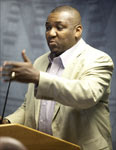


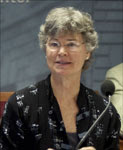
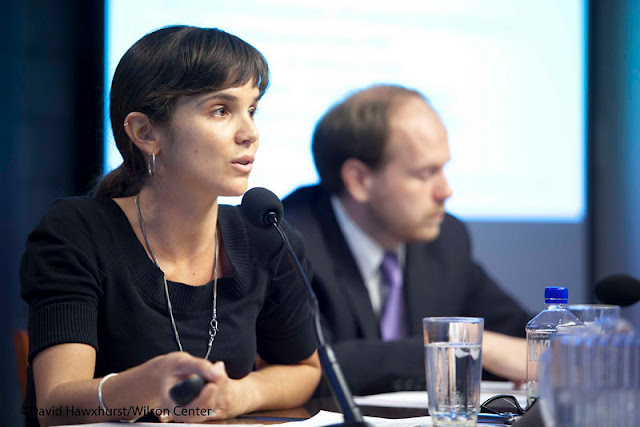



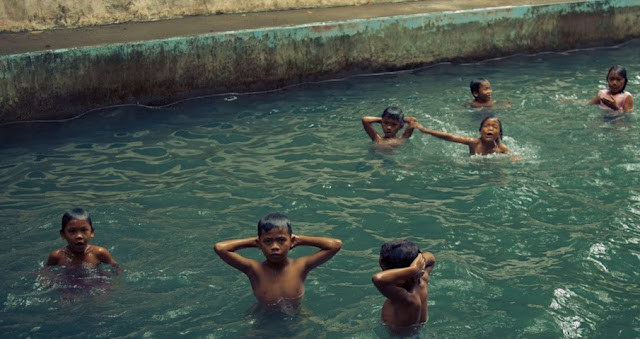
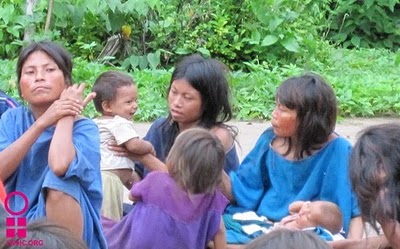

 “Water disputes that can start at the local level—little things—have the potential, in extreme cases, to burgeon into something much bigger,” warned Ken Hackett, president of
“Water disputes that can start at the local level—little things—have the potential, in extreme cases, to burgeon into something much bigger,” warned Ken Hackett, president of 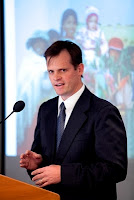 Prior to witnessing violent protests within the Altiplano region of Bolivia, Jason Gehrig assumed that the primary obstacles to successful water development efforts would be found in the technical phase of designing or building delivery systems. Local political developments, however, demonstrated that “we can’t just be looking at development without also looking at the structural issues at play,” said Gherig.
Prior to witnessing violent protests within the Altiplano region of Bolivia, Jason Gehrig assumed that the primary obstacles to successful water development efforts would be found in the technical phase of designing or building delivery systems. Local political developments, however, demonstrated that “we can’t just be looking at development without also looking at the structural issues at play,” said Gherig.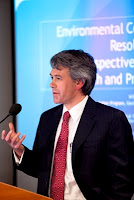 William Hall noted that conflict sensitive practices apply several elements of environmental conflict resolution (
William Hall noted that conflict sensitive practices apply several elements of environmental conflict resolution (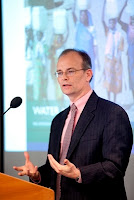 Tjip Walker noted that effective governance of water and other common pool resources, often magnets for mismanagement and contention, should be a pivotal concern for peacebuilders in fragile states. Drawing on research on governance and conflict, Walker explained that countries that are more democratic, and allow for greater social participation, are at a lower risk for violent conflict.
Tjip Walker noted that effective governance of water and other common pool resources, often magnets for mismanagement and contention, should be a pivotal concern for peacebuilders in fragile states. Drawing on research on governance and conflict, Walker explained that countries that are more democratic, and allow for greater social participation, are at a lower risk for violent conflict. Africa’s elephants and black rhinos—already at risk—are increasingly threatened as the
Africa’s elephants and black rhinos—already at risk—are increasingly threatened as the 

